Since this is the most popular entry-level DLSR model, the Internet is flooded with various optics types competing for the title of the best lens for Nikon D5500. Its 24.2 MP crop sensor and 39 AF points can obtain incredible results and the LCD touchscreen makes the use more convenient.
Combined with a long-lasting battery and convenience of handling, this device can promise extended service and it makes sense to equip it with a great piece of optics.
Below, you will find a selection of the absolute best lenses for this model. These will include professional and more affordable variants, devices for shooting nature or portraits, and anything you might need. Whatever takes your fancy in this list, be sure that it has the best balance between price and performance contained in a robust body.
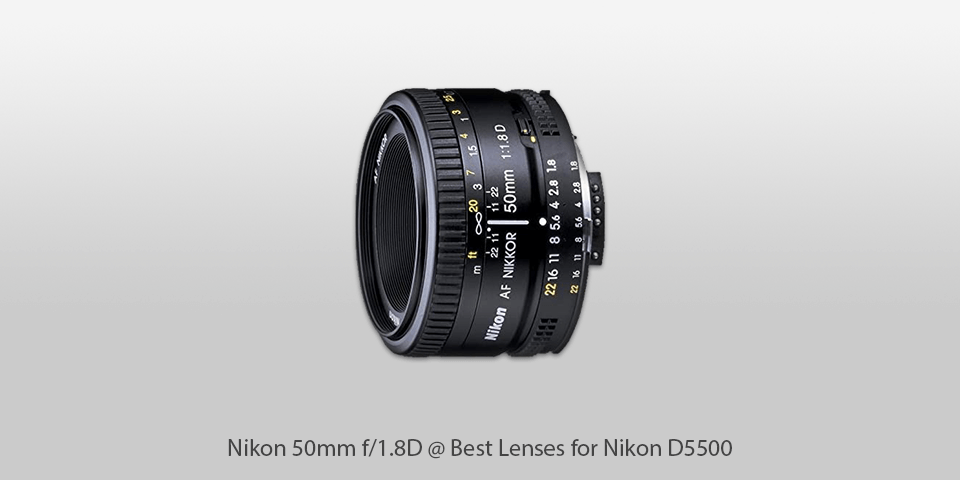
Mount: F | Diaphragm blades: 7 | Autofocus: yes| Min focus distance:45 cm | Max magnification: 0.15x | Filter thread: 58mm | Dimensions (WxL): 2.1 x 52.4 mm| Weight: 185 g
⊕ Captures even small details
⊕ Swift aperture
⊕ Reasonable cost
⊖ No vibration reduction or aperture ring
This model has many qualities to be called the best lens for Nikon D5500 as well as many other cameras, including those using film. For starters, it is lightweight and affordable so a perfect companion for amateurs and frequent travelers.
In addition, it has great optics providing clarity of image throughout the frame even at full aperture. The manufacturers eliminated chromatic aberration and provided pleasant bokeh. Naturally, with the price being low, there are some drawbacks and the absence of a traditional aperture ring can be considered one.
With the DoF scale being absent as well, photographers relying on zone focusing techniques would want an older model. If that is no concern for you, this is definitely a great piece of optics.
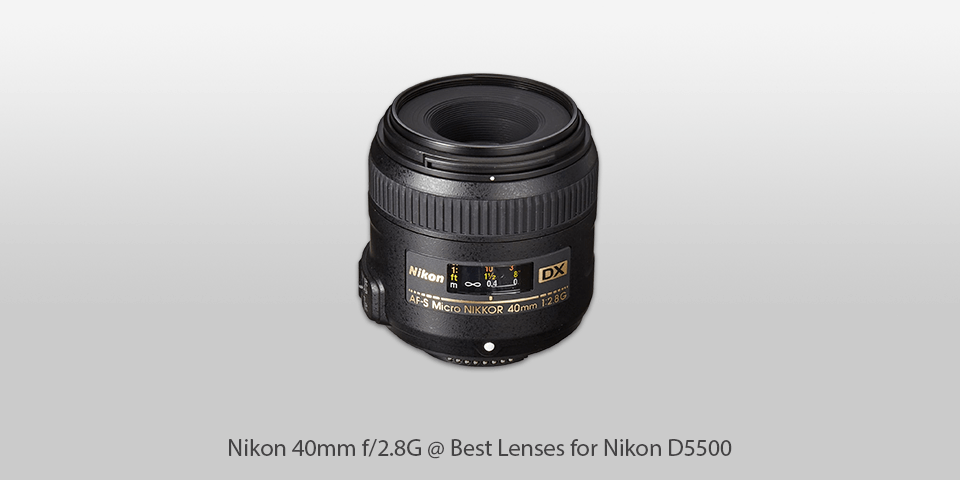
Mount: F | Diaphragm blades: 7 | Autofocus: yes| Min focus distance: 16.3 cm | Max magnification: 1x | Filter thread: 52mm | Dimensions (WxL): 68.5 x 64.5 mm| Weight:235 g
⊕ Clear shots
⊕ 1:1 magnification
⊕ Focus limiter switch
⊕ Small-sized body
⊖ Absence of stabilizer
⊖ Not full-frame
Another good lens for Nikon D5500 is optimized by the manufacturer to show the best results when attached to the camera body. This one received protection against dust and moisture as well as the enhancing ED glass to make its aspherical lenses perform better.
This model is practically noiseless with its SWM working quickly and efficiently. The M/A mode is helpful if you often switch between the two focusing modes.
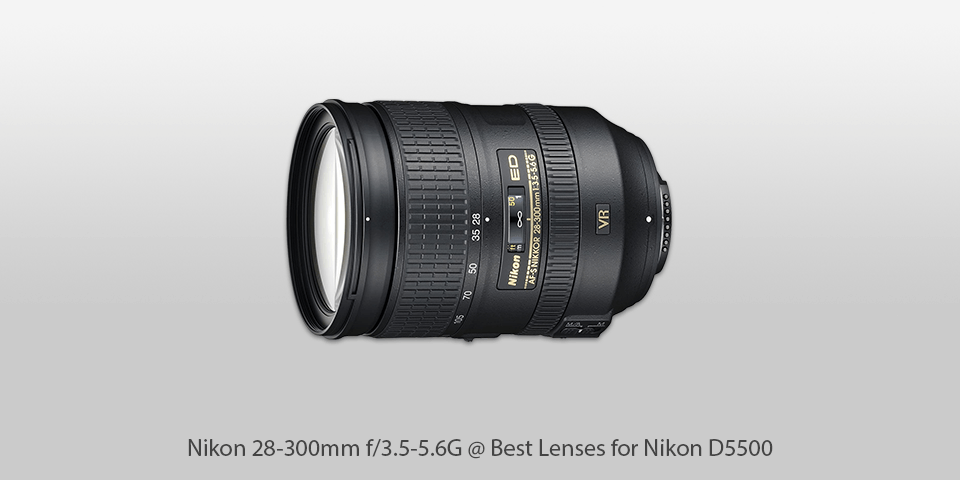
Mount: F | Diaphragm blades: 9 | Autofocus: yes| Min focus distance: 50cm | Max magnification: 0.32x | Filter thread: 77mm | Dimensions (WxL): 83 x 114.5 mm| Weight: 800 g
⊕ Sharp images
⊕ 10.7x zoom ratio
⊕ Optical stabilization system
⊕ Portable dimensions
⊖ Perceptible distortion
⊖ Soft edges at maximum aperture
For those who need a powerful zoom, this model would be a great option. The lens maintains an f/5.6 aperture as you’re working in the telephoto end and that allows you to get sharp photos. The brand’s stabilizing mechanism has the effectiveness of 3.5 stops.
This makes a huge difference when you’re taking images or even videos handheld. It is an optical device meant for outdoor use and allows you to picture closely the objects that a regular lens won’t capture.
However, that comes with a disadvantage that’s hard to eliminate, the distortion. Choosing this model, be prepared to either ignore it or, preferably, learn a few simple Lightroom tricks.
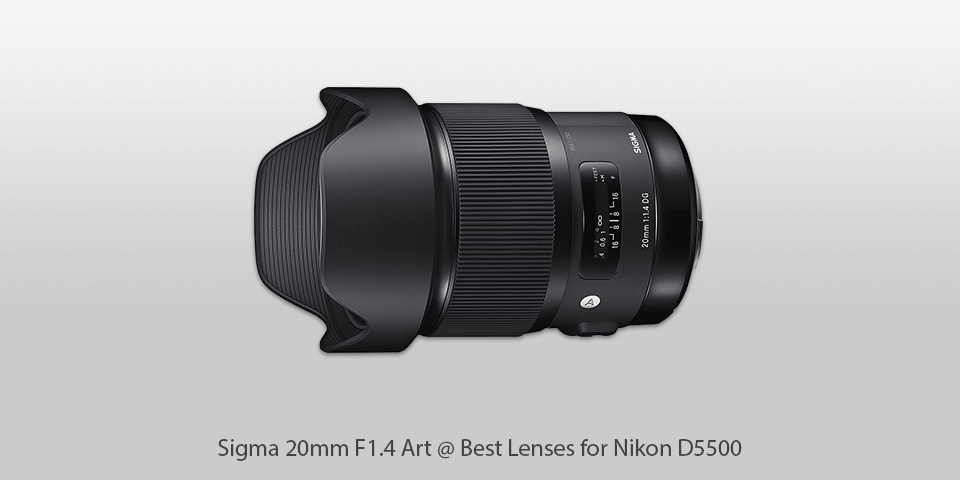
Mount: EF | Diaphragm blades: 9 | Autofocus: yes | Min focus distance: 27.69 cm | Max magnification: 0.14x | Filter thread: mm | Dimensions (WxL): 90.7 x 129.8 mm| Weight: 950 g
⊕ Overall image sharpness
⊕ Almost invisible distortion
⊕ Small minimum focus distance
⊕ Can be connected to multiple systems
⊖ Bulky
⊖ Dimness towards the edge
⊖ No connector for filters
This Nikon D5500 wide angle lens is a rarity because it has an unusually wide aperture for this type of optics. It captures lots of light, helping you obtain a very detailed image, but it also allows for a close focus.
There is very little barrel distortion, a great achievement of the manufacturer. The edges of the frame do get slightly dimmer but this effect is very hard to eliminate in a lens but super easy to wipe off in image editing software.
The lens is quite bulky but you should understand that this is the price for the superb performance and image quality unobtainable otherwise.
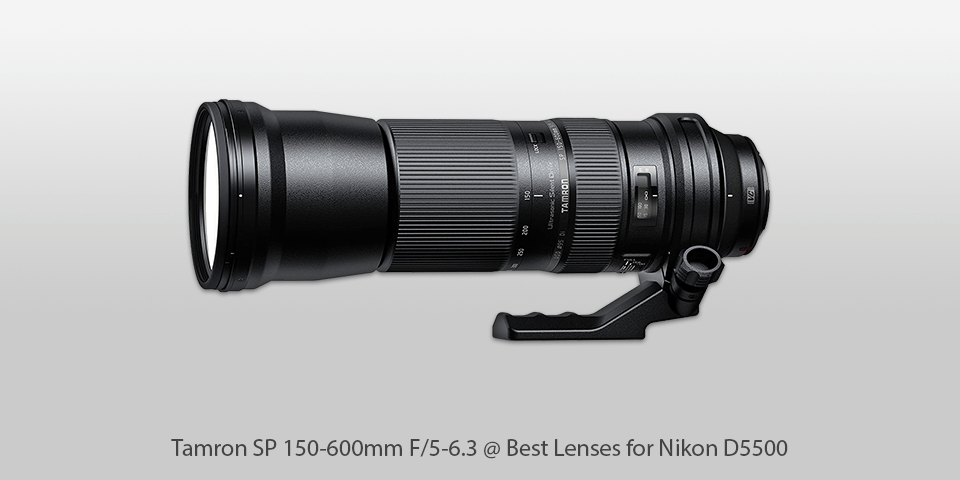
Mount: F | Diaphragm blades: 9 | Autofocus: yes| Min focus distance: 2.7 m | Max magnification: 0.2x | Filter thread:95 mm | Dimensions (WxL): 105.66 x 257.81 mm| Weight: 1.95 kg
⊕ Stunning sharpness
⊕ Excellent stabilizer
⊕ Swift AF
⊕ Zoom mechanism allows locking
⊖ Blurred edge at either extreme of the range
⊖ Autofocus performance issues
This is a great optical device with the longest zoom obtainable. It has been supplied with VC and USD to allow you to snap detailed pictures of distant or moving objects with the camera in your hands.
With the aid of the brand’s special optical technology that includes eBAND Coating, the lens neither catches glare nor creates ghosting, only takes clear vibrant pictures. The edges get dim when you reach either end of the zooming range, something you can hardly eliminate in a lens.
However, the performance in the middle of the range is flawless. To crown all, the lens is rugged and can stand any weather conditions but its body is relatively light. There is also an image stabilizing system within, so you can hardly be left with any doubts about the quality of this model.
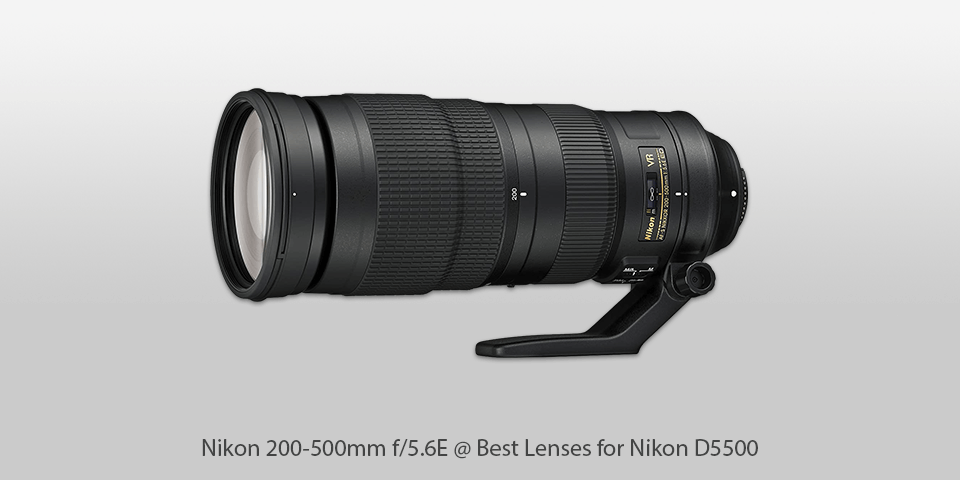
Mount: F | Diaphragm blades: 9 | Autofocus: yes| Min focus distance: 2.2 m | Max magnification: 0.22x | Filter thread: 95 mm | Dimensions (WxL): 108 x 267.5 mm | Weight : 5.07 pounds
⊕ Long-reaching telephoto
⊕ Static f/5.6 maximum aperture
⊕ Optical stabilization
⊖ Poor zoom if compared with competitors
⊖ Edge softening at 200mm
⊖ Won’t operate on older D-SLRs
This model would compete for the name of the best lens for Nikon D5500 with the next option which is also a telephoto. This one has a great Vibration Reduction that reaches up to ~4.5 stops and counteracts the somewhat narrow aperture. The latter might not satisfy professional sports photographers.
The lens is made out of ED glass so is a perfect tool for shooting in bright sunlight. In addition, it has a super-fast and practically noiseless motor that also allows manual override of autofocus. With the Electromagnetic diaphragm, it can sync seamlessly with any performance rate of the camera even with a teleconverter added to it.
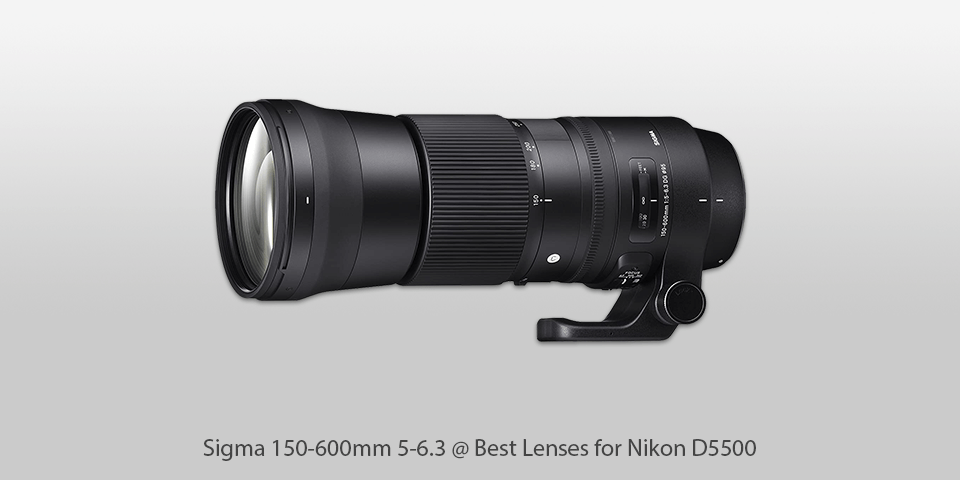
Mount: EF | Diaphragm blades: 9 | Autofocus: yes| Min focus distance: 2.8 m | Max magnification: 0.2x | Filter thread: 95mm | Dimensions (WxL): 10.2 x 4.1 x 4.1 inches| Weight: 4.3 Pounds
⊕ Furthest telephoto reach
⊕ Unbeatable sharpness
⊕ Comes with tripod collar and lens hood
⊕ Minor chromatic aberration
⊖ Visible pincushion distortion
If you look at all the incredible qualities of this model, you will imagine a much higher price tag. It maintains an astonishing sharpness of image up to the furthest points of the range. Reaching telephoto settings, it does show some blurriness at the edge together with minor color fringing.
There is also some pincushion distortion present but such small flaws are inevitable. They can certainly be overlooked when you take into consideration all the factors, like a portable design and the possibility to take astonishing images.
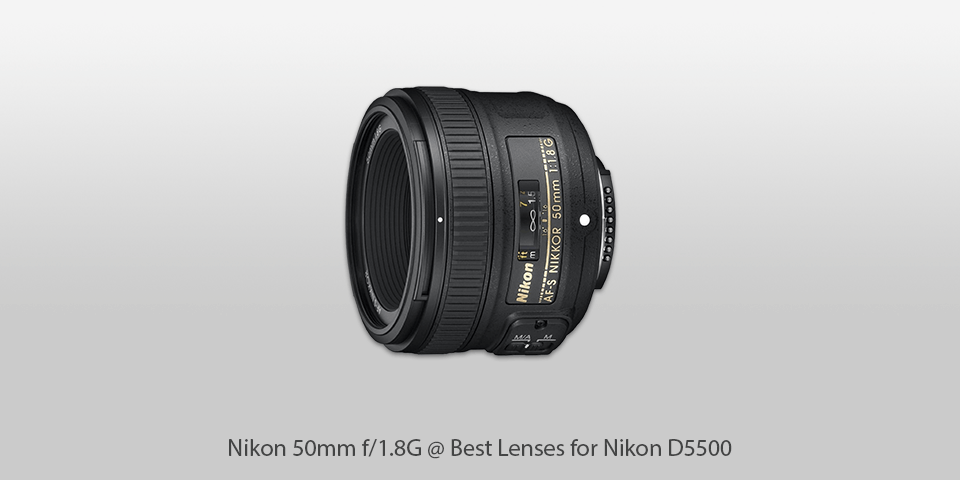
Mount: F | Diaphragm blades: 7 | Autofocus: yes| Min focus distance: 45cm | Max magnification: 0.15x | Filter thread: 52mm | Dimensions (WxL): 63.5 x 39 mm| Weight: 155 g
⊕ Mesmerizing clarity of shots
⊕ Lightweight and small
⊕ Multi-layer coating
⊕ Praiseworthy performance
⊖ Manual focusing
⊖ Can’t be paired with many cameras
If you’re looking for a Nikon D5500 prime lens appropriate for portraiture, here is a great option. Its fast aperture works like a charm for frames with a shallow depth-of-field, bringing the subject forward naturally. The lens can collect even more light due to the special enhancing coating that also prevents flares.
The aberrations are also taken care of with the introduction of an Aspherical Element so you can crank that diaphragm wide-open. The speedy motor is a nice touch, allowing you to focus quickly and silently. Obviously, the best feature of this model is amazing images produced at all times.
| Image | Name | Features | |
|---|---|---|---|
 |
Nikon 50mm f/1.8G
Our choice |
CHECK PRICE → | |
 |
Nikon 40mm f/2.8G
Budget |
CHECK PRICE → | |
 |
Nikon 28-300mm f/3.5-5.6G
Zoom |
CHECK PRICE → |
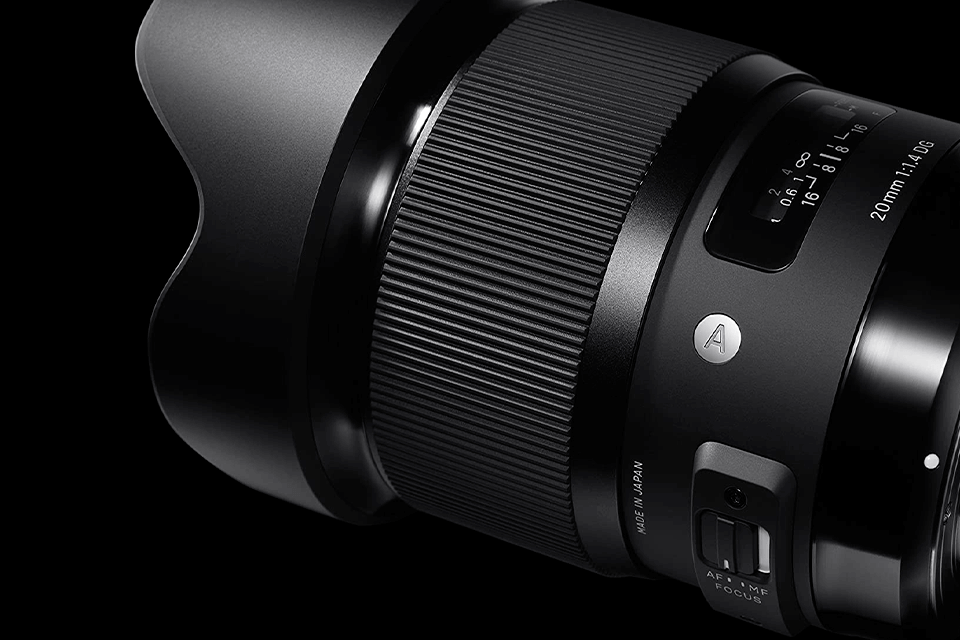
Naturally, you should acquire optics with consideration for your artistic aims. Start from estimating how wide of an angle and how much zoom you would need and then decide whether a standard would be enough or you need something like a telephoto.
The term defines the distance between the lenses’ optical center, which can shift position with the focus, and the camera’s matrix. If this number is low, the camera will create a wider frame, and the opposite case will allow it to zoom further.
For those shooting landscapes or the like subjects that require a wide angle of view, the 14-35mm focal lengths will be preferable. Photographers interested in wildlife, for instance, should be looking within the 50-100mm range.
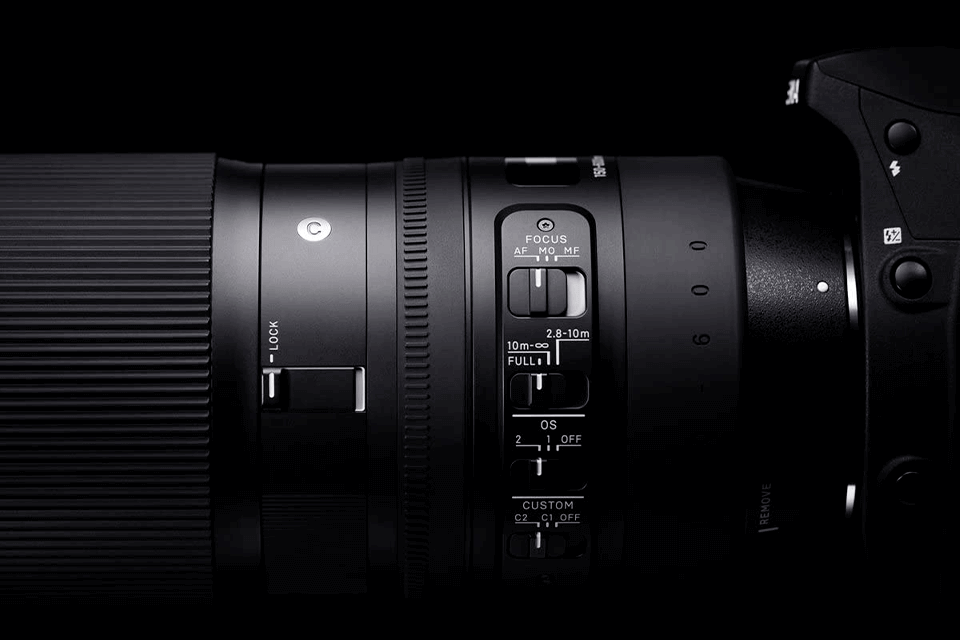
The aperture is responsible for letting the light to penetrate the optical system. The marking goes from a smaller number, which means more light, to a higher one, which means less.
The latter reduces the cost of the lens. Typically, the values between f/2.4 and f/3.2 are found in general use lenses and are convenient enough. A telephoto, for instance, would require a larger aperture to maintain image quality.
Among the most useful D5500 lenses, an inexpensive and pretty universal 18-140mm model should be your collection’s centerpiece. It is also highly advisable to get a 35mm prime over time. For those with a narrow interest in something involving motion or faraway objects, the 55-300mm f4.5/5.6 VR telephoto will be a great option.
Naturally, the answer would vary with consideration to genres. If you’re uncertain or want something universal, get an 18-55 mm. This is a great tool for experimenting but also a quality lens for work. As you gain skill, try a prime for higher quality visuals.
Yes. Any lens that works for one DX camera will be good for the other.
If you want to stick to the brand, the AF FX NIKKOR 50mm f/1.8D Lens is the most affordable in their production line. When the need pushes to find the cheapest compatible model, the YONGNUO YN EF 50mm f/1.8 AF Lens YN50 Aperture Auto Focus is inexpensive and comes with a cleaning cloth as a bonus.

 Rating
Rating